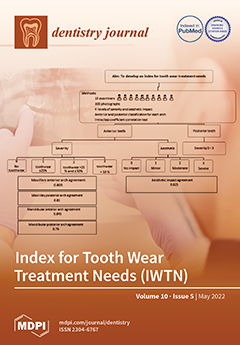Bone grafting procedures during the use of dental implants may be avoided by the use of tilted implants in the maxilla and the mandible; advantages of angled implants are associated with the extension of the distal cantilever, leading to better implant survival rates. However, the bending effect on the single tilting implants may increase the marginal bone stress. The purpose of the present study was to retrospectively assess the clinical success and proximal bone loss rate following the implantation of distally tilted implants according to the All-on-Four™ prosthetic concept—based on radiographic findings—in a single-center experience, in addition to the assessment of the outcomes in the context of various clinico-epidemiological correlates. During the study period,
n = 36 patients (24 males and 12 females) with complete records of periapical radiographs, received a full-arch fixed bridge supported by two axial and two distal tilted implants; overall
n = 144 and
n = 144 implants (Nobel B) were place in the maxilla and mandibles of patients, respectively. Mean age of patients at the time of fixture installation was 58.75 ± 13.71 years;
n =11 patients presented with relevant underlying conditions/habits. To assess peri-implant bone-level changes, matched and calibrated orthopantomogram (OPT) images were taken at follow-ups after 1.5 years, 2.5 years, and 3.5 years post-restoration, and marginal bone levels were assessed on the mesio- (MA) and disto-approximal (DA) aspects. All implants were successful, resulting in a 100% overall survival rate. The radiographic mean bone loss levels at baseline (mean ± SEM) were 0.181 ± 0.011 mm and 0.178 ± 0.017 mm in the maxilla and mandible, respectively, while by the 3.5-year mark, bone loss was 0.770 ± 0.029 mm and 0.713 ± 0.026 mm in the maxilla and mandible (
p > 0.05), respectively; bone-level changes were significant over time (
p = 0.035 and
p = 0.033). Peri-implant bone loss was more aggressive around titled distal implants versus mesial actual position implants. The effect of smoking and other underlying conditions showed significantly higher (
p < 0.05) bone resorption levels when assessed on an individual implant-level, while during patient-level analysis, only a tendency was shown for higher bone loss rates for both MA and DA implants (
p > 0.05). Within its limitations, our study has concluded that the use of All-on-Four™ prosthetic concept for total arch rehabilitation yields higher bone loss in association with tilted implants and, in some cases, on the MA surfaces at vertically positioned implants after >40 months in function.
Full article






